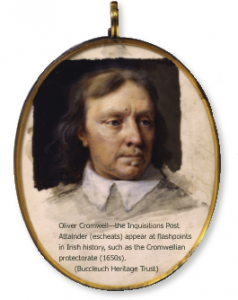Inquisitions,Post Mortem and Inquisitions Post Attainder—lesser-used sources for Irish genealogy
Published in Early Modern History (1500–1700), Featured-Archive-Post, Features, Issue 6 (November/December 2013), Volume 21 The Inquisitions are ‘treasury’ documents, recording the rights and privileges of the crown over land held by tenants-in-chief in Ireland. The Inquisitions Post Mortem were surveys undertaken by the court of chancery or exchequer at the time of death of the landholder. The earliest start in 1276 but there is a notable gap between the reign of Henry VI and c. the 1530s. The resumption indicates an administrative revival of crown government in Ireland.
The Inquisitions are ‘treasury’ documents, recording the rights and privileges of the crown over land held by tenants-in-chief in Ireland. The Inquisitions Post Mortem were surveys undertaken by the court of chancery or exchequer at the time of death of the landholder. The earliest start in 1276 but there is a notable gap between the reign of Henry VI and c. the 1530s. The resumption indicates an administrative revival of crown government in Ireland.
The Inquisitions Post Attainder (escheats) were used to survey the lands of attainted rebels—i.e. those declared ‘corrupt’ in the blood, whose lands were confiscated by the crown. They appear at flashpoints in Irish history, with the greatest frequency during the Nine Years War (1590s) and the Cromwellian protectorate (1650s).
The use of Inquisitions to ‘survey’ land in Ireland continued to the 1650s, followed by a slow decline, although Inquisitions Post Attainder and some Post Mortem were used right up to the reign of William and Mary. This is contrary to the situation in England, where the practice ended at the start of the Civil War and was formally abolished in 1660 by the Tenures Abolition Act. Their continued use after 1660 emphasises Ireland’s colonial status and ongoing political instability.
What is recorded?
Their value to the family historian is that the Inquisitions allow us to link names to places at a particular point in time and provide detailed familial relationships across generations. The Inquisitions are particularly useful when tracing English and Gaelic families in Ireland between the 1530s and the 1690s. The type of information contained includes:
— the name of the deceased, date of death, and often also age at death, as well as all chief lands;
— the name and age of his heir (tail male) or heiresses (heirs general);
— the name of his widow and any lands that were part of her jointure, or the name of a predeceased wife (always including her maiden name);
— the names of sons and daughters who receive annuities or portions of the estate.
In addition, the Inquisitions that survive from the early modern period often include the names of people to whom land has been mortgaged, or lease agreements that record the tenants’ names and identify the lands and acreage leased. Many of these holdings are surprisingly modest—the Inquisitions are not restricted to major tenants only.
Inquisitions can also include details of deeds of trust—feoffees to uses—taken out to try and avoid the lands being taken back into crown hands before they were regranted to the heirs. Other information will include the names of trustees, dates of death of the trustees and the names of the new trustees who replaced them. By the 1600s in Ireland trusts were also used to avoid the potential religious ramifications of having to take the Oath of Supremacy at the time of claiming an inheritance. (Unlike Ireland, in England laws on trusts were changed during Henry VII’s reign.)
Where can you find the records?
In the 1820s the Records Commissioners prepared transcripts of Chancery Inquisitions by province, and calendars were published for Leinster and Ulster: Inquisitionium in officio Rotulorum Cancellaria Hibernia . . . , vol. 1, Lagenia (Dublin, 1826), and vol. 2, Ultonia (Dublin, 1829). Transcripts for Munster and Connacht were never published but these survive in manuscript form in the National Archives. The records are calendared in the original Latin and are abbreviated—and are not for the faint-hearted!
The Records Commissioners’ transcripts of the Exchequer Inquisitions, which contain similar information but were primarily concerned with crown revenue, also survive in manuscript form in the National Archives. None of the Exchequer material has been published, with the sole exception of County Dublin. The Records Commissioners also prepared a separate series of transcripts of deeds and wills recited in Inquisitions Post Mortem, which survives in manuscript form in the National Archives.
The value of the Commission’s calendars and transcripts is that they provide substitutes for original documents that were destroyed in the Four Courts in 1922. In most cases they are the only copies now available. HI
Fiona Fitzsimons is a director of Eneclann, a Trinity College campus company, and of findmypast Ireland.
















